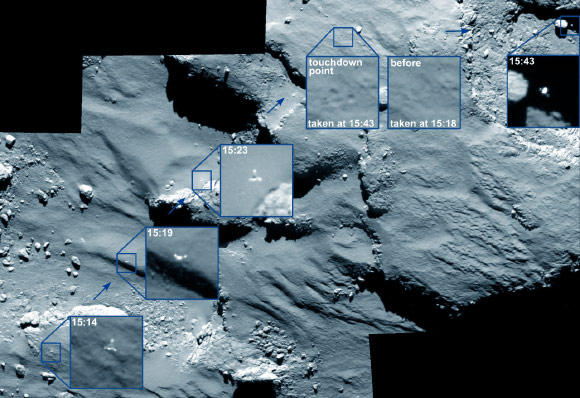New images released by the European Space Agency (ESA) show the journey of Philae as it approached and then rebounded from its first touchdown on Comet 67P/Churyumov-Gerasimenko.

The OSIRIS narrow-angle camera aboard Rosetta spots the Philae probe drifting across Comet 67P/Churyumov-Gerasimenko; the time of each of image is marked on the corresponding insets and is in GMT (EDT+5, PDT+8, CET-1). Credit: ESA / Rosetta / MPS for OSIRIS Team MPS / UPD / LAM / IAA / SSO / INTA / UPM / DASP / IDA.
The images were captured on 12 November 2014 by the OSIRIS narrow-angle camera aboard ESA’s Rosetta spacecraft over a 30 minute period spanning the first touchdown.
A comparison of the touchdown area shortly before and after first contact with the surface is also provided.
The images were taken when Rosetta was about 17.5 km from the comet center, or roughly 15.5 km from the surface. They have a resolution of 28 cm/pixel and the enlarged insets are 17 x 17 m.
From left to right, the images show Philae descending towards and across the comet before touchdown.
The image taken after touchdown, at 10:43 a.m. EDT (7:43 a.m. PDT, 3:43 p.m. GMT, 4:43 p.m. CET), confirms that the lander was moving east, as first suggested by the data returned by the CONSERT experiment, and at a speed of about 0.5 m/s.
The final location of Philae is still not known, but after touching down and bouncing again at 12:25 p.m. EDT (9:25 a.m. PDT, 5:25 p.m. GMT, 6:25 p.m. CET), it reached there in seven minutes.
The imaging team is confident that combining the CONSERT data with OSIRIS and navcam images from the orbiter and images from near the surface and on it from Philae’s ROLIS and CIVA cameras will soon reveal the lander’s whereabouts.







